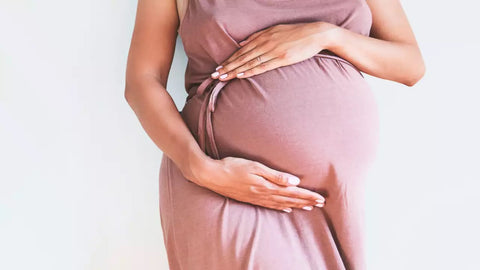The arrival of menopause means that the female reproductive system stops working and must adapt to the cessation of its activity.
Some women may miss their periods or pregnancies, but the transition also brings some discomforts and we must ensure that none of them cause major problems in the long term.
During a woman's fertile life, estrogen keeps the vagina moist, elastic and with adequate blood flow, but when ovarian function ends with the drop in estrogen levels, the tissues of the genitourinary system atrophy.

The vaginal epithelium atrophies during menopause due to estrogen deficiency. This causes a loss of glycogen-rich surface cells and an increase in parabasal cells. All of this results in increased dryness that can cause pain.
What symptoms do these changes result in?
Most of the symptoms are part of the so-called Genitourinary Syndrome of Menopause, a range of chronic genital, sexual and urinary problems that, far from solving themselves, can worsen over time if not treated.
The hypoestrogenism characteristic of menopause leads to a general atrophy of the genital tract. The characteristic is a loss of elasticity of the vulvar introitus, as well as a reduction in both the vaginal glands and the thickness of the vaginal squamous epithelium, which leads to a decrease in lubrication. In addition to all these changes, there is also an alteration of the normal vaginal flora that protects the mucosa from pathogenic microorganisms and leads to a higher risk of local infections.
The gynecological changes that occur during menopause give rise to various symptoms: dryness, burning, vaginal itching, dyspareunia, vaginitis, a feeling of fullness in the vaginal introitus, and others.
On the other hand, it is very common that such symptoms, together with urinary symptoms and the psychological and sociocultural changes typical of menopause, interfere to a greater or lesser degree with a woman's sexuality.
The prevalence of symptoms related to genitourinary atrophy in menopause is not well defined. This is because many women consider these symptoms to be an inevitable consequence of aging, which means that they do not seek medical help. Prevalence studies estimate that symptoms of urogenital atrophy affect between 10 and 40% of postmenopausal women.
Urinary tract infections
Urinary tract infections are common in women of all ages, although the prevalence shows that they increase with age; in fact, approximately 10 to 15% of women over 60 suffer from frequent urinary tract infections. The origin of these infections is related to changes in the bacterial flora that are secondary to the increase in vaginal pH that occurs with menopause; in this situation, the vagina is colonized by bacteria other than those that constitute its usual microbiota, which probably increases the woman's susceptibility to urinary tract infections: urethritis, cystitis...

Urgency-frequency syndromes and incontinence
Urinary urgency-frequency syndromes are directly related to urogenital atrophy secondary to decreased estrogen production. This situation involves the loss of voluntary control of urination, which results in an urgent and compelling need to urinate. This disorder affects at least 30% of women over 65 years of age .
Urinary incontinence becomes more frequent as a person ages and is estimated to affect approximately 25% of women over 60 years of age . This disorder has important physical, psychosocial and economic repercussions and its main risk factors include age, pregnancy, childbirth and obesity. The relationship between incontinence and estrogen reduction is not fully proven, however, hypoestrogenism causes the entire pressure system of the urinary tract to fall, which together with the gradual deterioration of the urethra and bladder, favors the appearance of stress incontinence .
On the other hand, the worsening of urinary urgency leads to the appearance of another type of incontinence, the so-called urgency urinary incontinence . Both types of incontinence (stress, urgency) are extremely common in women after the onset of menopause.
Vaginal Dryness
From a gynecological perspective, one of the first reasons for consultation in postmenopausal women is vaginal dryness; some women report it associated with intercourse, causing a decrease in sexual relations, although in many cases this is not the only cause, since other circumstances that coincide at this stage of life must be taken into account.
Vaginal dryness can cause various symptoms, such as vaginal itching, dyspareunia and vulvodynia.
Atrophic vaginitis is caused by hypoestrogenism , which among the different alterations it causes in the vagina, causes a decrease in glycogen content, which prevents the maintenance of the normal vaginal microbiota ; this normal flora maintains the acidity of the vaginal pH, but when it disappears, this pH becomes alkaline and favors the growth of a mixed flora that predisposes to the development of infections.
The entire symptomatic procession described above improves significantly by instituting a treatment with estrogens ; its effectiveness has been proven, both when administered orally and vaginally.
Another therapeutic option is non-hormonal vaginal lubricants , which may be useful as maintenance therapy in patients with mild symptoms.
Sexual dysfunctions
Menopause causes a series of hormonal changes that interfere with sexual response; in this sense, hypoestrogenism gives rise to different genital alterations that make it difficult to maintain sexual relations. In addition to these genital alterations, the decrease in estrogen causes a decrease in libido.
At the same time, psychological and sociocultural factors have a significant influence on female sexuality at this stage of life; a very high percentage of women relate menopause with the end of reproductive life, and at the same time, with the end of sexual life.
In any case, numerous studies indicate that the presence or absence of female sexual dysfunctions at this stage is closely linked to the relationship with the partner and the physical condition of both; in fact, if the couple has a good emotional relationship and does not suffer from physical problems that limit it, sexual activity can be maintained for life.
In other cases, the presence of sexual dysfunction at this stage is not necessarily related to menopause and its consequences; it is quite common for the origin of this problem to be the presence of common chronic diseases or even for it to appear as a side effect of commonly used drugs such as sedatives or tranquilizers that act on the central nervous system and influence sexual response.
Regarding therapeutic options, psychotherapy, non-hormonal therapy or hormone replacement therapy, either with estrogen alone or with androgens, may be used; studies using the latter indicate that there is an improvement in desire, libido and sexual activity in general.
References
What is hypoestrogenism? Medical Dictionary - Clínica U. Navarra. (nd).
Martín, R., Soberón, N., Vázquez, F., & Suárez, JE (2008). The vaginal microbiota: composition, protective role, associated pathology and therapeutic perspectives. Infectious Diseases and Clinical Microbiology, 26(3), 160–167.
Fernández, B. (2021, April 14). What is Urge Urinary Incontinence? Why does it occur? How to solve it? Lyx Institute of Urology.
Pablos, G. (2023, July 3). How menopause changes a woman's body. ELMUNDO.




Comments (0)
There are no comments for this article. Be the first one to leave a message!